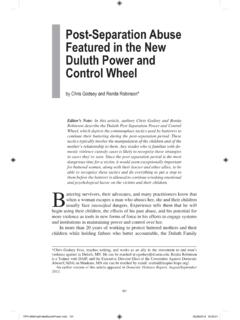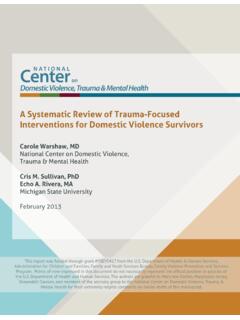Transcription of The Effectiveness of Batterer Intervention Programs
1 The Effectiveness of Batterer Intervention Programs A Literature Review & Recommendations for Next Steps [Abridged version] Patricia Cluss, PhD, and Alina Bodea, MD, MPH UNIVERSITY OF PITTSBURGH March 2011 [A longer version of this report that includes part of the CDC report on measurement instruments for battering and copies of the original articles is available by contacting: We thank the FISA Foundation for providing support for the preparation of this report. PERMISSION GRANTED TO REPRODUCE AND DISSEMINATE FOR EDUCATIONAL AND RESEARCH PURPOSES TABLE OF CONTENTS Section Page Background 2 Purpose of the Report 2 Part 1: Review of the Literature Review procedures 3 A note about scientific research design 4 Research formats and their ability to detect solid findings 4 Why it s hard to study Batterers Intervention Programs (BIPs) 6 Part 2: Factors Involved in Understanding the Research Literature on BIPs Types of interventions studied 8 Research sites 9 Populations studied 9 Outcome measures employed in BIP research 9 Part 3.]
2 Major Findings in the Literature about BIP Effectiveness Results of individual higher-quality studies 10 A note on the results of couples Intervention studies 12 Results of meta-analyses and literature reviews 12 Other articles of interest 12 Part 4: Conclusions and Recommendations for Next Steps What we know so far 15 What we don t know yet 16 Recommendations 17 Conclusion 18 Appendix A: Reference list grouped by quality 19 Appendix B: Summaries high-quality articles 25 Appendix C: Summaries of medium-quality articles 42 1 The Effectiveness of Batterer Intervention Programs Background domestic violence (DV) is a major social and women s health concern.
3 At least 85% of DV victims are women and approximately million women in the experience physical or sexual violence from a current or former intimate partner each year. Nearly half of female victims sustain an injury at some point in the course of the abuse and 41% require medical care as a result of a physical assault by their partners. A long-term impact on health outcomes for women victims has also been documented, with reports of ongoing physical complaints such as gastrointestinal disorders, chronic pelvic pain, adverse pregnancy outcomes, decreased control over contraception and increased numbers of unintended pregnancies, among other chronic concerns.
4 This health burden translates into higher health services use and costs. Female victims are twice as likely to use health care services than non-victims, with times the health care costs. One study calculated costs of $ billion per year for direct medical care in the as a result of female victimization in relationships. Much effort and expense in this country appropriately has gone into providing services and support for victims of domestic violence. However, focus on domestic violence batterers the individuals who actually cause the problem has lagged far behind the focus on victims in the areas of prevention and Intervention .
5 For example, a quick search of the comprehensive MEDLINE journal database in 2010 found 3606 articles on the topic of domestic violence victims and only 838 on the topic of domestic violence batterers. As a result of this lack of focus on batterers, relatively little is known about what constitutes a quality Batterer s Intervention program (BIP) model. Despite this lack of information, however, formal standards of care have been developed for BIPs and implemented in many states since the 1990s, based primarily on policy makers beliefs about what constitutes a good program.
6 Pennsylvania has been working on its own standards for many years, without reaching consensus about what they should contain. Locally, it has been difficult to obtain reliable outcome data from existing local Programs , so that organizations in the Pittsburgh area who work with batterers, such as the court system, and with DV victims, such as the local women s shelter Programs , have been uncertain about the quality of BIPs. More information is needed both locally and nationally to inform the program development and evaluation of BIPs and to determine next steps for research into effective BIP Programs .
7 Purpose of the Report The purpose of this report is to provide a full and critical review of the Effectiveness of batterers Intervention Programs as evaluated in recent research published in peer-reviewed journals in the fields of medical and social science. We also make recommendations for next steps for researchers and BIP program developers, based on the results of the review. This review focuses only on group models of Intervention , as there is very little research into individual models of Batterer treatment. 2 Part 1: Review of the Literature Review procedures: A systematic search of MEDLINE and PsychINFO online databases was carried out during the months of July and August 2010 by the second author of this report.
8 Several search combinations were employed using the keywords batterers and perpetrators. We exploded these terms in the search criteria, meaning that the search returned not only articles related to the selected keyword but also all of their more specific terms in the thematic areas of: partner abuse , domestic violence, intimate partner violence, Intervention , treatment, and evaluation. The search focused on literature published describing empirical studies published from 1990 to mid-2010 and resulted in a comprehensive list of relevant articles. Literature reviews and meta-analyses (see Format subsection below) published since 2000 were also identified.
9 Other authoritative information sources were consulted for the purpose of identifying additional relevant publications. These sources included: the Centers for Disease Control s (CDC) Center for Injury Prevention webpage; the World Health Organization s World Report on Violence and Health (2002), and the Mincava Electronic Clearinghouse at the Minnesota Center Against Violence and abuse . As the articles found through this initial search strategy were read and reviewed, additional relevant articles were identified from the reference sections of those articles.
10 Studies identified as a result of the search were then reviewed and categorized according to their format and quality. Format: Articles on the Effectiveness of BIPs were categorized as those reporting on single studies, systematic reviews of existing studies, or meta-analyses. Single studies are those where one Intervention approach was evaluated either with or without a control group or where one approach was tested against another in a sample. A systematic review is a literature review that tries to identify, evaluate, and integrate the research evidence relevant to a particular question or issue.










